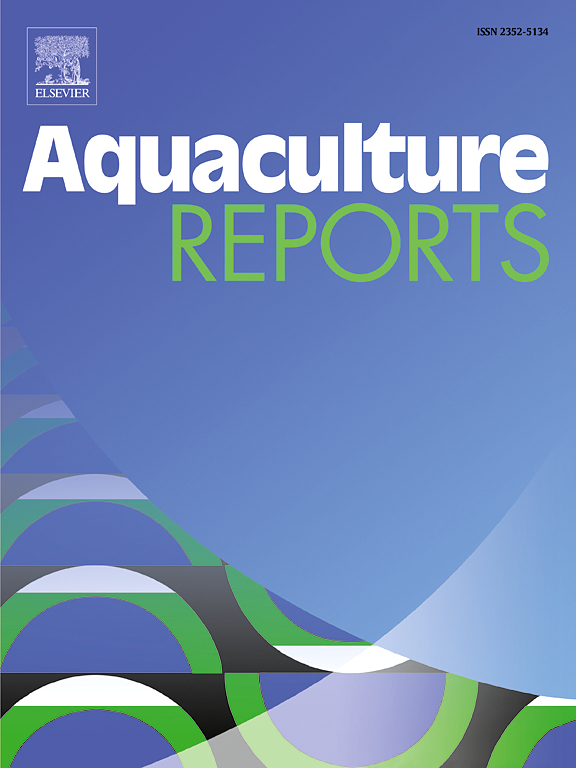Dietary protein/carbohydrate ratio and swimming activity modulate mitochondrial performance and oxidative metabolism in gilthead sea bream (Sparus aurata) juveniles
IF 3.2
2区 农林科学
Q1 FISHERIES
引用次数: 0
Abstract
This study compares the effects of a high-protein diet (HP) and a high-carbohydrate diet (HC) on energy metabolism, mitochondrial homeostasis, and oxidative stress in gilthead sea bream juveniles, and examines how swimming activity modulates these effects in a 6-week trial. Both diet and exercise induced tissue-specific metabolic responses, adjusting enzyme activity and gene expression based on substrate availability and energy demands. HP-fed fish exhibited higher hepatic protein content and increased activity of enzymes involved in aerobic metabolism (Cs) and protein catabolism (Alat) compared to HC-fed fish. Hepatic expression of genes related to mitochondrial biogenesis (sirt1, tfam, pgc1a), dynamics (mfn1, mfn2, miffb, fis1), energy metabolism (cox4a, cs, ucp1, hadh), and oxidative stress (sod1, sod2, cat, gpx1, gpx4, gst3, prdx5) was also higher in the HP-fed group. In red muscle, mitochondrial activity was more pronounced in HC-fed fish, as evidenced by increased expression of sirt1, pgc1a, ucp2, and antioxidant-related genes. White muscle exhibited minimal changes in response to diet composition, with HP-fed fish displaying slightly higher oxidative capacity, and HC-fed fish showing stronger activation of glycolytic pathways. Exercise reduced plasma triglyceride levels and upregulated mfn1, glut4, and ucp2 expression in red muscle, while liver and white muscle function remained mostly unaffected by swimming activity. Gilthead sea bream juveniles demonstrated notable metabolic adaptation to a carbohydrate-rich diet, presenting minor diet-induced changes at the molecular level, with skeletal muscles showing high metabolic plasticity. Furthermore, exercise enhanced nutrient utilization, especially under high carbohydrate intake, providing a suitable strategy for using protein-adjusted diets to promote more sustainable farming of this species.
日粮蛋白质/碳水化合物比和游泳活动对金头鲷幼鱼线粒体性能和氧化代谢的影响
本研究比较了高蛋白饮食(HP)和高碳水化合物饮食(HC)对赤头鲷幼鱼能量代谢、线粒体稳态和氧化应激的影响,并在为期6周的试验中研究了游泳活动如何调节这些影响。饮食和运动都能诱导组织特异性代谢反应,根据底物可利用性和能量需求调节酶活性和基因表达。与hc喂养的鱼相比,hp喂养的鱼表现出更高的肝脏蛋白质含量和参与有氧代谢(Cs)和蛋白质分解代谢(Alat)的酶的活性增加。与线粒体生物发生相关的基因(sirt1、tfam、pgc1a)、动力学(mfn1、mfn2、miffb、fis1)、能量代谢(cox4a、cs、ucp1、hadh)和氧化应激(sod1、sod2、cat、gpx1、gpx4、gst3、prdx5)的肝脏表达在hp喂养组也较高。在红肌中,hc喂养的鱼的线粒体活性更明显,sirt1、pgc1a、ucp2和抗氧化相关基因的表达增加就是证据。白色肌肉对饲料组成的反应变化很小,hp喂养的鱼表现出稍高的氧化能力,hc喂养的鱼表现出更强的糖酵解途径的激活。运动降低了血浆甘油三酯水平,上调了红肌中mfn1、glut4和ucp2的表达,而肝脏和白肌功能基本不受游泳活动的影响。幼鱼对富含碳水化合物的饮食表现出显著的代谢适应,在分子水平上表现出轻微的饮食引起的变化,骨骼肌表现出高度的代谢可塑性。此外,运动提高了营养物质的利用,特别是在高碳水化合物摄入的情况下,为使用蛋白质调整饮食提供了合适的策略,以促进该物种的可持续养殖。
本文章由计算机程序翻译,如有差异,请以英文原文为准。
求助全文
约1分钟内获得全文
求助全文
来源期刊

Aquaculture Reports
Agricultural and Biological Sciences-Animal Science and Zoology
CiteScore
5.90
自引率
8.10%
发文量
469
审稿时长
77 days
期刊介绍:
Aquaculture Reports will publish original research papers and reviews documenting outstanding science with a regional context and focus, answering the need for high quality information on novel species, systems and regions in emerging areas of aquaculture research and development, such as integrated multi-trophic aquaculture, urban aquaculture, ornamental, unfed aquaculture, offshore aquaculture and others. Papers having industry research as priority and encompassing product development research or current industry practice are encouraged.
 求助内容:
求助内容: 应助结果提醒方式:
应助结果提醒方式:


